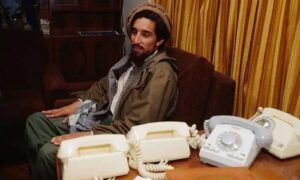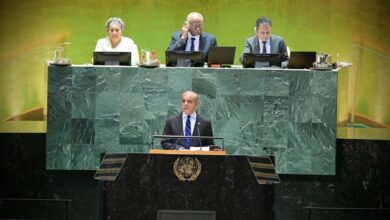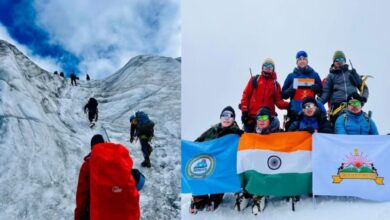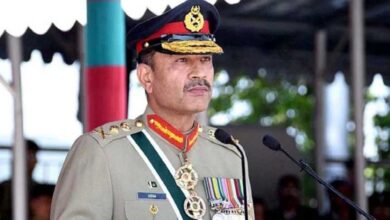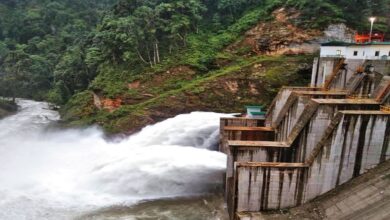How Bin Laden killed Ahmad Shah Masood
Until a couple of years ago, the first thing that caught the eye at the Kabul airport was a huge poster of Ahmed Shah Masood. Not only that, the main traffic circle of Kabul was also named after him.
But everything changed after the Taliban came back to power.
First, his picture was torn down at the Kabul airport and the places named after him were also changed.
But to many people in Afghanistan, he is still a national hero.
American writer Robert Kaplan compared Ahmad Shah Massoud to Mao Zedong and Che Guevara as a guerrilla commander.
Sandy Gall, author of his recently published biography, Afghan Napoleon: The Life of Ahmad Shah Masud, wrote: Even his Russian opponents admired the vitality of their adversary, who had to fend off at least nine Russian attacks over eight years. He was a staunch opponent of the Taliban throughout his life.
Many people admire his intelligence, humility, courage and his knowledge of Persian literature. His entire life from the age of 22 to 49 was spent fighting.
Like the Taliban, he never compromised with Al-Qaeda.
Other Afghan resistance fighters would go outside the country hoping for foreign support, but he never left his country during the Soviet occupation.
He continued to fight in Panjshir under very difficult conditions.
Personally he lived a simple life. He was never accused of abuse of power or corruption.
A British officer compared him to Marshall Tito, the leader of the Yugoslav independence movement.
As the Taliban advanced on Kabul, he went alone to the Taliban camp to broker a deal despite the ban of his fellow fighters, writes Sandy Gall. His companions feared that he would be killed by the Taliban as soon as he entered the camp, but his personality was so influential that he returned alive.
Mullah Omar dismissed one of his own commanders to allow Ahmad Shah Masud to return alive.
He loved reading so much that when he had to leave Kabul in 1996, he took two thousand books with him.
Ahmad Shah Masud adopted a very simple but effective strategy in the war against the Russians.
AR Rowan, in his book ‘On the Trail of Lion Ahmed Shah Masud’, wrote that before firing rockets and mortar shells into the base, the Russians laid numerous landmines on the roads leading to and from the camp, which his troops knew in advance. After shelling for a while, they avoided the landmines and attacked them (the Russians). When the Russian soldiers tried to bring in help from outside to avoid the attack, they all fell victim to landmine explosions.
After months of fighting, the Russians left the Panjshi Valley. Later they attacked the valley nine times and each time Masud forced them to retreat.
Despite massive support from Pakistan and triple the numbers, the Taliban were never able to defeat Masood.
Masud blew up the Salang tunnel at the mouth of the valley with dynamite and blocked it in his own area. He then went from village to village exhorting the people to be ready to give their all to protect their area.
Osama bin Laden also initially sided with Masood in the fight against the Russians, but later had deep disagreements with Masood and was the one who killed Ahmed Shah Masood.
Two Arab journalists came to interview Ahmed Shah Masood in August 2002. They had Belgian passports.
Later it was found that they had stolen those passports from the Belgian embassy.
Al Qaeda actually sent them to kill Masood.
One of them was 39-year-old Abdesattar Dahmane and the second man was named Bowari-al-Qair. He was 31 years old. Both were quite tall. One had the appearance of boxers. Neither of them had beards. Both wore pants-shirts.
On the instructions of Masud, the commander of the area, Bismillah Khan, sent a vehicle to the check point to pick them up.
A month ago, the Pashtun leader Abdul Rasul Saif received a call from his old Egyptian friend Abu Hani, asking him to give his two Arab friends the opportunity to interview Ahmad Shah Masood.
Both first traveled from London to Islamabad and from there reached Kabul.
From there they reached Panjshir. They were Saif’s guests for several days.
In a statement to Scotland Yard, Amrullah Saleh said the Panjasheri driver told Afghan authorities that the two men were telling him to drive carefully because they had some sensitive equipment.
Bismillah Khan, the commander of the area, also noted that although the two had no beards, the skin near their chins was yellow, indicating that they had long beards, but they had recently trimmed them.
He noticed it but ignored it at the time.
After staying as Saif’s guests for a few days, the journalists were brought to the valley and put up in Masood’s guest house.
There they met a British tourist and writer Matthew Lemming.
Lemming later wrote in an article entitled ‘Breakfast with the Killers in The Spectator’, the two seemed to me to be very quiet and rather mysterious people. After killing Masud I realized that I spent five days with those murderers.
At the dinner table, when I asked them where they were from, they replied that they were from Morocco, but were actually from Belgium. When I tried to discuss tourism in Morocco, they were not interested in the conversation. They both ate a lot of rice and meat.
He also wrote, after a few days when they opened up to me, they asked if you have General Masood’s number? I said no. I don’t think he gives his number to anyone. When I asked why they wanted to meet him they said they needed a TV documentary.
Masood’s oldest friend, Masood Khalili, was Afghanistan’s ambassador to India at the time. He left Delhi for Almaty on September 5, 2001 to meet the Kazakh Foreign Minister. Masood called him and invited him to meet.
Khalili flew from Almaty to Tajikistan’s capital Dushanbe on September 7. Khalili was about to go to sleep in the hotel room when Amrullah Shah called him and told him that Masood had arrived and wanted to meet him immediately.
Khalili took off her nightgown and put on other clothes, accompanied by Masud’s nephew and soldier Atesho Wadud, and reached his house in Masud’s black bulletproof Mercedes car.
Masood and I were talking about terrorism in Kashmir and India. I said goodbye to Masud at 12:30 pm. He came out to say goodbye to me, which was not normal. His colleagues told me that the next day between 10 am and 11 am we will leave for Afghanistan by plane. The flight took 40 minutes to reach Khwaja Bahiuddin town. In the meantime I took several pictures of the Commander.
In the evening, Wasim, the protocol officer of the Ministry of Foreign Affairs, came and asked Masood, do you want to meet the journalists of Saudi Arabia? It has been almost a month since they arrived in the Northern Alliance area and for the past nine days they have been waiting to meet you at Khwaja Bahauddin.
The next day Ahmad Shah Masud gave them time for an interview. He and Khalili were together that night. The two of them were talking till about half past midnight. Ahmed Shah Masud reached his office at around 11 o’clock the next day.
Masood Khalili told Scotland Yard that Ahmed Shah was wearing a khaki shirt and military jacket. I got a new passport a few days ago. When I showed it to him, he told me to put it in my coat pocket or it might get lost. Masoud tells me that two Arab journalists have been waiting for me for two weeks. I was about to take a bath, but Masood stopped me and said that this interview was only for five-ten minutes.
Khalili also said that during the interview I sat on the right side of Masud. I was so close to him that our shoulders were touching. I asked the interviewer, which newspaper are you from? In response, they said, we did not come from any newspaper.
I am from the Islamic Center of Europe. I told Masud, these are not journalists. Masood nudged me lightly with his elbow and said, ‘Let them work. Then Masud asked them how many questions you will ask? They take out a piece of paper and start reading their questions. They had a total of 15 questions. There were eight or nine questions about Osama bin Laden.
Their first question was, how is the situation in Afghanistan? As soon as Khalili translated it, there was a terrible explosion.
I didn’t hear the explosion, but saw a blue ball of fire coming towards me. I remember, until then I had knowledge. I feel a hand on my chest. It was Ahmad Shah Masud’s hand. After that there was no consciousness.
The explosion shook the entire building. The blast was so powerful that Aref and Jamshid, Ahmed Shah Masood’s associates, thought the Taliban might have launched an airstrike there. The Saudi killers placed the camera right in front of Masood, but the bomb was actually hidden in the interviewer’s belt.
All the guards of Masud rushed there. An almost unconscious Masood first asked Khalili to get up. Masood was immediately rushed to the helipad in a car.
Aref, Masood’s bodyguard, later stated this in his testimony.
Ahmad Shah Masood was bleeding all over, I also saw a small part of a finger on his right hand blown off by the explosion. Masood, Khalili and the injured were taken by helicopter to the nearby Tajik city of Farkhar, Aref said during testimony.
Masood Khalili felt like I was in a helicopter. I was able to open my eyes for about 10-15 seconds. I saw blood on Masud’s face and hair. Then I passed out again. Eight days later I regained consciousness, by which time I had been taken to a hospital in Germany. My wife informed me that Ahmed Shah Masood is no more.
When Khalili’s wife opened his luggage, she found his passport, which Ahmad Shah Masood had forced him to put in the top pocket of his shirt.
My wife opened my passport. It had many bomb splinters till the 15th page. Maybe that’s why I survived. If only the commander had put my passport in his own pocket! Afghanistan needed him more than I did.
When Masood reached Farkhar, an Indian doctor present there declared him dead. Ahmed Shah Masood died within minutes of the blast, his guards said.
The incident was kept secret from the outside world for several days, so that the Taliban could not take this opportunity to launch a new military campaign against the Northern Alliance.
Masood was assassinated two days before 9/11, but due to 9/11, the incident was not discussed enough.
Masud Khalili thinks that Al Qaeda was behind the murder.
He told Scotland Yard that Osama bin Laden wanted to create a religious divide throughout Afghanistan and Central Asia. It would not have been possible if Ahmad Shah Masood had not been removed.
Osama knew he would need protection after what he was about to do in New York. The killing of Commander Masood was in a way a gift to Taliban leader Mullah Omar so that he could provide Osama with the security he needed in the future.

